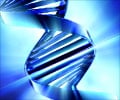
"This is a totally unexpected but wonderful finding," Ybe said. "It has exciting implications for understanding the role that clathrin may play in the growth or suppression of tumors."
Ybe is a senior research scientist in the Department of Molecular and Cellular Biochemistry in the IU College of Arts and Sciences. Co-authors of the paper are postdoctoral researchers Sarah Fontaine and Xiaoyan Lin; IU chemist Todd Stone; Sanjay Mishra, formerly at IU and now at Vanderbilt University; and Jay Nix of Lawrence Berkeley National Laboratory.
Typically found in a three-legged form called a trimer, clathrin is best understood for its role in endocytosis, the process by which cells absorb proteins and other molecules. But recent research has suggested that clathrin in a one-legged form, or monomer, may have a role in suppressing tumors. Ybe and his team show how a "switch" in clathrin can be flipped to produce non-trimeric clathrin molecules.
"Clathrin is known to function as a trimer in receptor-mediated endocytosis, but the existence of the monomeric form and its role in tumor suppression is less well-accepted," said Alexandra Ainsztein, who oversees membrane trafficking grants at the National Institute of General Medical Sciences of the National Institutes of Health. "By providing evidence for a model in which a molecular shift de-trimerizes clathrin and changes its cellular distribution, this work will spur further research into unanticipated roles for this important molecule in healthy and diseased cells."
In endocytosis, trimeric clathrin molecules bind together to form molecular packages that allow other substances to enter cells. Several years ago, researchers in Japan published evidence that clathrin can also serve as an activator of the protein p53, a known tumor suppressor.
Advertisement
Using X-ray crystallography, Ybe and his team discovered a "topology switch" in the clathrin molecule. They showed they could break the switch by mutating one key amino acid that is part of the switch. The result: Clathrin was "detrimerized"; three-legged molecules were broken into one-legged ones.
Advertisement
Ybe said the results point to the need for additional research to better understand the structure and function of clathrin and the role it plays in cellular processes, including those involved in cancer. With the clathrin "switch" identified, researchers can attempt to better understand how it can be activated, with the goal of developing new therapies for suppressing the growth of tumors. Ybe has a patent pending on the idea to use the mutated form of clathrin to stimulate the natural anti-cancer activities of human cells.
The finding developed from Ybe's research on the role of clathrin in Huntington's disease, a genetic disorder that causes neurological degeneration and is estimated to affect about 15,000 people in the U.S. The National Institutes of Health awarded the project a $1.2 million, four-year grant in 2009. The NIH grant number is R01GM064387.
Source-Eurekalert










